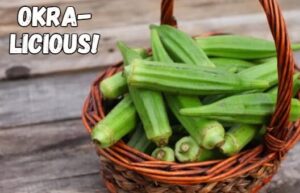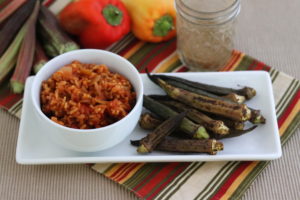 “I love it!”
“I love it!”
“I hate it!”
“What is it?”
These are the most frequent responses we hear when we ask people about okra! And many people are just like we used to be – we had no idea what to do with it and thought it had to be fried! That’s the only way to eat it, right?!
In many parts of the country, okra is in-season right now. It is a perfect time to enjoy it, so keep reading to learn more about what it is, why it is good for you, and what to do with it!
What is okra?
 This heat-loving plant grows well in a variety of warm climates including Africa, south Asia, China, Australia and the southern United States, and this sturdy plant can grow as high as 6 feet tall! The edible fuzzy green pods are what we know as “okra,” but in some countries, they are referred to as “lady fingers.” And because it has seeds, it can be argued that okra is technically a fruit!
This heat-loving plant grows well in a variety of warm climates including Africa, south Asia, China, Australia and the southern United States, and this sturdy plant can grow as high as 6 feet tall! The edible fuzzy green pods are what we know as “okra,” but in some countries, they are referred to as “lady fingers.” And because it has seeds, it can be argued that okra is technically a fruit!
Okra is interesting because it’s a delicacy in the southern part of the U.S. (often fried) while it can be unfamiliar to those in the northern parts of the U.S. That’s likely because okra grows best in warmer and higher humidity climates, where temperatures consistently reach 85 degrees or more. The best time and place to get okra is during late summer at local farmers’ markets.
For those who think they don’t like okra, we know what you are thinking…it’s too slimy. This unique texture allows okra to act as a great thickener for meals like gumbo. And, there is great news — if prepared properly, okra can be slime-free!
Why eat okra?
Okra adds tremendous flavor and texture to meals…plus, it’s loaded with nutrients! Some of its most important health benefits:
- Full of fiber, which provides many health benefits including sopping up cholesterol and reducing the risk of certain cancers.
- Great source of Vitamin K, which is important for blood clotting and good bone health.
- Includes powerful antioxidants including Vitamins A & C.
- Loaded with folate, which helps reduce the risk of birth defects in expectant mothers.
- Good source of mucilage, which is responsible for the “slime,” but also does wonders for our digestive systems. Think of it as a lubricant for your digestive system, helping to remove waste (including cholesterol) and ease constipation.
How do you select and store okra?
 Most of the okra you will find is green. Look for pods that are bright green, firm and dry. You don’t want any wet or soft areas. You might also find a red or purple variety of okra, which tastes the same as the green variety and actually turns green when cooked. Many think the smaller pods are more tender – 2 to 4 inches tend to indicate they were harvested at the right time. If they are left on the plant too long, they can get tough and woody, which you want to avoid.
Most of the okra you will find is green. Look for pods that are bright green, firm and dry. You don’t want any wet or soft areas. You might also find a red or purple variety of okra, which tastes the same as the green variety and actually turns green when cooked. Many think the smaller pods are more tender – 2 to 4 inches tend to indicate they were harvested at the right time. If they are left on the plant too long, they can get tough and woody, which you want to avoid.
It is best to use your okra within a few days of buying it and you can store it in the refrigerator prior to use (keeping it dry until you use it).
Freeze it!
Okra also freezes beautifully! Preserve your fresh okra so you can enjoy it all year long:
- Rinse and de-stem the okra.
- Blanch the whole okra by placing it in boiling water for 3-4 minutes (depending on the size). Blanching the okra will help it maintain that bright green color and fresh picked flavor.
- Transfer the okra to an ice bath (bowl of ice water) to stop the cooking process. Drain and pat dry.
- Leave the pods whole or slice them into bite size pieces.
- Flash freeze them first by freezing them in a single layer on a baking sheet. (This lets them freeze individually so they aren’t all stuck together.)
- Once the okra is frozen, transfer them to freezer bags and place back in the freezer. Try to use the okra within one year for the best quality.
What can you do with okra?
Unfortunately, okra most often gets paired up with the deep fryer, but it is also incredibly good prepared outside the fryer! There are some fantastic ways to prepare it, while preserving the health benefits. It adds tremendous flavor and texture to meals like gumbo and jambalaya and is absolutely delicious grilled, pickled, roasted and sautéed, or even eaten raw.
Some of our favorite ideas:
End of Summer Chicken Foil Packet
For best results…
The substance responsible for the slime-like texture provides health benefits and can act as a thickener in certain dishes. In other preparations, when this texture is unwanted, there are ways to avoid it.
Here are just a few tips:
- Use smaller pods.
- Make sure the pods are dry before cooking.
- Cook the okra whole.
- If you cut it, you may need to wipe your knife occasionally.
- Cook the okra quickly at high heat – or roasting in the oven is a great option.
- If sautéing, don’t overcrowd the pan.
- Add an acid — lemon juice, vinegar, wine…and even tomatoes…work great!
- Don’t add salt at the beginning of cooking, as this can release the liquids in the pods.
- Some also recommend soaking the okra in vinegar for 30 minutes before cooking, and then rinsing and patting dry. We view this as optional, as we have had good results without this step.
We hope this provides some inspiration to enjoy the okra harvest the next few weeks.
We really want you to enjoy the flavor, nutrition and other benefits these powerful pods have to offer!
 LEARN MORE ABOUT THE NAPKIN!
LEARN MORE ABOUT THE NAPKIN!



We grow okra here in Michigan. Some years are better than others, hot miserable summers are best. So yummy!